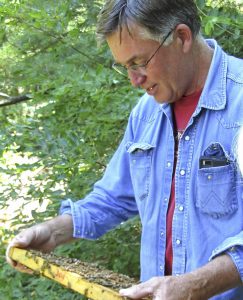
 South Dakota is Buffalo and Indian land in the northern part of the Midwest.
South Dakota is Buffalo and Indian land in the northern part of the Midwest.
I talked to Chris Baldwin some time ago. He is a commercial beekeeper running about 1500 bee colonies. In summer his bees are closer to his home in South Dakota. In February they pollinate Almonds in California. After that they are going to east Texas for queen breeding and splitting. Focus in handling the mites is not eliminating the mites, says Chris. It’s eliminating susceptible bees.
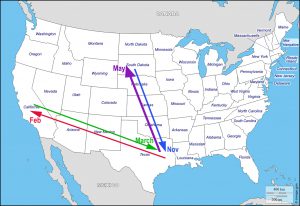 Beginning of November the bees go to Texas for winter. February 1 to California for Almond pollination. March to Texas for splitting and supering. May to South Dakota for honey. (Basic map illusttration: http-//d-maps.com_carte.php?num_car=5184&lang=en)
Beginning of November the bees go to Texas for winter. February 1 to California for Almond pollination. March to Texas for splitting and supering. May to South Dakota for honey. (Basic map illusttration: http-//d-maps.com_carte.php?num_car=5184&lang=en)
Chris hasn’t been treating his bees against mites for more than ten years. Last Coumaphos 2003, Only Oxalic 2004 and 2005. Nothing in 2006 and finally Thymol in 2007. After that nothing. He’s loosing bees yes, but not because of mites really. He’s keeping bees like bees were kept before the arrival of the Varroa mite. When he talked to another commercial beekeeper recently, his comment about Chris’ bees was that they probably could handle all farmers chemicals better as they didn’t had to deal with miticides as well in their hives.
Blacklisted
When he shares his experiences with others he is many times surprised of the response, or lack of response. Maybe some think he’s earning money on selling queens from his “pretended varroa resistant bee stock”. Maybe because almost all(?) scientists say you must treat against mites to get your bees to survive. But Chris don’t do that. He lives on his bees producing honey and pollinating crops.
There are so many examples now of treatment free operations for many years that we can write down a working plan to produce resistant stocks. It’s not telling the whole truth leaving out the growing number of treatment free beekeepers and their working plans for their success.
When he talks to scientists, many well known, about his bees, they look kind of strange in silence for a while and then walk away. They don’t show up at his yards wanting to investigate his bees and methods to find out more, as you would expect.
Chris has good references, the bee inspectors in his areas in South Dakota and Texas.
Once he had a columnist from a bee journal showing up asking and looking at his operation. I’m sure the readers would have loved to know more about how Chris is managing his bees. But he’s doing many things the opposite way to what many times is preached from the front.
No wonder he said to me he feels like he’s blacklisted. By whom and why, if that’s the case?
A bigger picture
After some additional communication with Chris about his operation the picture gets more clear and gives more food for thought. It’s really interesting and valuable to put his experiences and management system beside others’ to get a better understanding of our fascinating honey bee and what it means to us as an economic resource and understanding its role in nature.
California in February
Chris may well be the only big commercial beekeeper focused on pollination services that is treatment free when it comes too the Varroa mite. His bees are exposed to agricultural chemicals, drifting of other beekeepers’ bees into his colonies (which may well bring mites and pathogens of different kinds) and his bees visiting weakened hives to rob from (and pick up mites and pathogens).
It’s not difficult to understand that his bees might well have problems due to this. Pathogens like nosema, plus chemical residues from spraying of the almonds for example and extra mites and viruses picked up will make life hard for the bees when they go back east Texas in March after almond pollination in California.
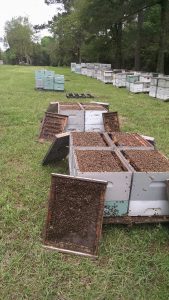
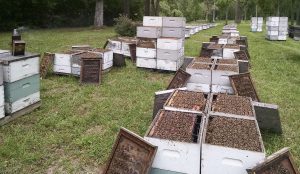 After pollination in California the bees go to Texas, here ready for supering.
After pollination in California the bees go to Texas, here ready for supering.
Texas in March
The colonies return to Texas in late March. There they are supered for growth and maybe honey production. April flows in Texas are unpredictable.
Not all colonies went to California from Texas February 1 for pollination of the almonds. The remainder are scattered to out yards for buildup and also prepared for cellbuilding, which begins in early March in Texas. Nucs are made in March and April.
Africanization is not a problem in east Texas and his number of hives is big. So his drones dominate the air well. Also there are few fives from other beekeepers in his area.
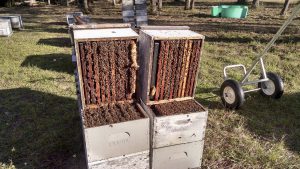 Preparing cellbuilders in early March with colonies that stayed in Texas when the main part went to California.
Preparing cellbuilders in early March with colonies that stayed in Texas when the main part went to California.
Securing cellbuilding
In a commercial operation every part in the system have to work good enough to make the system work and bring food on the table. One part that is maybe more critical than others is cellbuilding in the queen breeding part.
European Foulbrood has grown to a persistent problem in America. It may well bee due to increasing amounts of chemical residues in for example wax combs putting higher pressure on the immune system of the bees.
Chris will not have the chemical residues from miticides, which may well help his bees keep a better standard on their immune system than bees in other commercial outfits. Still he can during springtime at just the time of cellbuilding experience some problems from European Foulbrood. To be sure he will be able to produce the number of queen cells he needs, he gives the colonies involved some tetracycline in spring. That takes care of this problem efficiently. This is the only drug he uses.
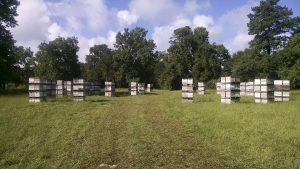 Colonies prepared for going from Texas to South Dakota for honey production during summer.
Colonies prepared for going from Texas to South Dakota for honey production during summer.
Summer in South Dakota
Colonies that have collected enough of honey for a food reserve are shipped to South Dakota for the clover flow, starting early May. Or they may stay in Texas longer for the Chinese Tallow tree bloom. It is often a difficult decision which will give the best flow.
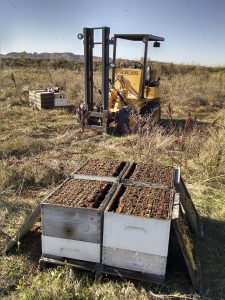 After harvest in October iSouth Dakota. Honey supers are removed.
After harvest in October iSouth Dakota. Honey supers are removed.
Winter in Texas
Harvesting of honey may begin in July and go through October in South Dakota. The bees are fed if necessary, then shipped to Texas early November, hopefully before the first blizzard in South Dakota.
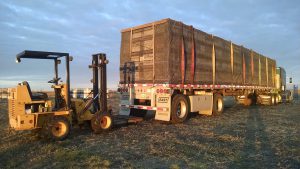
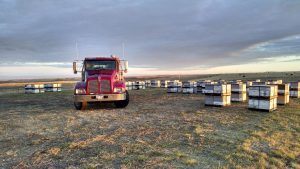 544 colonies loaded for transport from South Dakota to Texas in November. Another 544 colonies are waiting to be loaded.
544 colonies loaded for transport from South Dakota to Texas in November. Another 544 colonies are waiting to be loaded.
Annual losses
During summer about 20% of the colonies are lost due to queen problems. At least partly these queen problems may come from the rough circumstances in the pollination services environment. Pathogens and chemicals picked up there. In January the die offs are taken care off, as well as the bees alive. If necessary colonies are fed. Winterlosses and losses experienced after the almonds in California can together be 10-20%.
This makes a total annual loss of about 40%, which these days is the average in America, wheather you treat against mites or not. Quite some years ago now Chris had a “CCD-year” with 70% losses. But weather was favorable and he could recover colony numbers from remaining colonies in one season.
40% losses is a little too high, but up to 30% are okey for Chris in his management system. Actually some amount of losses are more or less needed to weed out the worst colonies and multiply the best to improve the stock continuously and keep the numbers stable. Also to minimize the swarming through making nucs. He is not into selling colonies or queens. He gets his income from pollination services and honey production.
Hive configuration
Beekeepers love to discuss different details in their management system. One is the hive configuration. And you can have quite animated discussions going on concerning how good or bad this or that part is, for example 8 or 10 frame boxes and medium or Langstroth boxes. What you many times forget is that each part of a management system, including the hive configurtaion’s different parts, is a result of this whole management system in which each part fits well enough for the beekeeper. If you change one part, you may have to change also other parts to make the system work well for you. And special circumstances for you may play a role why you have chosen the solutions you use.
Chris Baldwin uses a 10-frame system with a shallow box (5 & 11/16”; frame 448 x 137 mm) on the bottom. It is always there. It’s kind of an expansion space which the bees use as they want, more or less without control from the beekeeper. The bees remodel, tear down and build back, the combs in the frames there. Sometimes they are bad in shape, sometimes a lot of drone comb, sometimes good looking well used by the bees.
The next box is a Langstroth deep with 9 combs (frame 448 x 232 mm) and a plastic division feeder. It’s tight, but that keeps out burr comb. When moving combs the feeder is first taken out to make space for easier handling. This is the broodnest all the time. Then comes the queen excluder. The supers are normally 8 combs in 10 frame deep boxes and medium boxes (the latter frame 448 x 159 mm) with metal spacers. Almost no plastic combs are used, but wired wax foundation in wooden frames, since many years.
The bees
Colonies can grow very big on this set up. His bees uses the combs for brood efficiently. They are much more conservative, frugal with food reserves, than common Italians in America. He has always liked the darker kind of bees, Caucasian and Carniolan types. Today he has all colors. He started selecting among his bees creating his own stock many years ago. When the Russians came on the scene he started buying breeder queens of those and they changed the game concerning Varroa resistance. He refers to his friend Kirk Webster having the same experience using Russians.
Old combs
He uses no system for wax renewal. Well, he does in a way. After the queen breeding and nuc season is over, when a colony dwindle, for example looses its queen or having a failing queen, he doesn’t have any queen cells to save such colonies.
Broodnest boxes, deeps and shallows from these failing colonies go on top on other colonies as honey supers. After harvesting these boxes are extracted separately. The uncapper has adjustable cutting depths. When extracting brood combs he sets the uncapper on the deepest cut settings. It really cleans up the oldest nastiest comb.
Many of his brood nest boxes stay out in the field for years, but a certain number do get extracted and thus cleaned up quite a bit. He only cull combs that look horrible or have broken frames. Most of his combs are more than forty years old.
Nucs
He in first place uses the extracted brood combs when making nucs. He starts the nucs with three good deep brood frames and fills up the box with extracted deep combs and maybe a food comb. This box is put on a shallow extracted box. The nuc gets a ripe queen cell and maybe a good feed.
Broodnest
This hive setup, which has a smaller brood nest than many others use (many use two deeps), works fine in his management system. As annual losses are somewhat high (which is the “normal” average in America) many nucs are made. Still the colonies have time to grow to be strong enough for both pollination and honey production. And this is done just perfect with this 1 and ½ box broodnest setup. When he moves hives, he can take a bigger number, 4 stories with 4 hives on a pallet, 544 on a truckload.
Cellsize
Chris doesn’t really care about cellsize. If he did he maybe would have to change management system when it comes to wax renewal. He hasn’t found any reason for using more labor in this part of his beekeeping.
So what is the cellsize in his combs? Today when he buys wooden frames with plasic foundation (these are cheapest and quickest to get at work into the system), most common is 5.4 mm, to begin with. Forty years ago who knows, maybe 5.2 mm was what was bought, (sizes 5.1-5.6 was available). But during the years cell volume has shrinked of course due cocoon residues. When old combs have been cut down, the cell bottoms have been left untouched. The parts of the combs closest to the midribs are “smaller cell” still, by the added cocoon residues. But the compactness of a real small cell comb is not there (more cells per area unit).
Living life
Beekeeping makes you nature focused and Chris often observes wildlife while working the bees. Deer, antelope, hawks, eagles, owls, praire dogs, coyotes, pheasants, grouse, badgers and so on. He once saw six bull elk out on the praire. At another time a golden eagle carried off a coyote. The land in South Dakota isn’t as flat as it appears many times, but it’s so treeless that you often can see horizon to horizon.
What about next season then? Weather comes up differing with cold and heat, drought and rain. And we need rain too besides sun. Next season will always be better!
Chris Baldwin is doing his share in putting food on the table in US through his bees’ pollination services, and yes, somewhat also on many other tables around the world that import almonds.
Thank you, Very interesting to hear about a treatmentfree commercial operations. As for scientists, there are a few now, definitely, supporting treatment-free advocacy.
Yes, scientists ought to have brains too. I know several nice ones. Sometimes they put much stress on other obligations, like funding, to keep them going. Which is understandable. I’m glad for all kind of people that focus on helping bees to develop their skills in surviving and identifying and removing mens’ activities that make life harder for them. Would be nice to get some more names on scientists that are focusing primarily on Varroa resistance and treatmentfree beekeeping.
Hi Erik, It is nice to see another article about Chris. I met Chris and you at the NE treatment free (TF) conference in 2010. Debbie Delaney of University of Deleware raised treatment free bees and recognizes their importance. The main American scientists are vehemently against TF beekeeping and directly blame spread of varroa on TF beekeepers, Shameful behavior!!!
Thanks for your work…look forward to your next article.
Yes, Chris is a very honest and nice guy, well worthy our respect. Before blaming TF beekeeping they should ask if they could be allowed to visit them and make alcohol wash tests to clearify the varroa level in their colonies, before blaming them of spreading mites. Chris Baldwin’s referenses are the bee inspectors in Texas and South Dakota. I think that is well enough. What has happened to the bees of Debbie Delaney?
Hello Erik,
Kirk Webster was here last week to speak to our club. He spoke about Chris and said that the only change Chris made to become TF was to purchase Russian breeder Queens. Kirk estimated that only 10 were purchased, and everything else remained the same.I was lucky to meet Chris at the TF conference with you.
It is encouraging that articles in ABJ by Seeley, Oliver, and Milbraith, are all saying that we need better bees not better chemicals. Even we little beekeepers have to do it ourselves, no one else will help us.
Hello Gregory, Glad to hear from you and that we see more scientists speak up for better bees. I’m convinced your beekeeping operation make a change as well.
Gregory, has the Darwinian Beekeeping article by Tom Seeley been published? It was expected in March issue of ABJ.
Do the antibiotics for European foul brood. Help with the virus found with mites?
Antibiotics in general have no effect on virus. So I would say no. Resistance against viruses have to come from a good immune system and good genetics. But most important an ability by the bees to keep the number of mites low in the hive, first to fight mites in the brood. But most important top be able to stand reinvasion by a good grooming ability, to rid themselves and other bees in the hive from mites.
Thanks
Nice article, Erik.
You mentioned that an important measure of Chris Baldwin is to remove the susceptible bees in his mangement system. Can you highlight a bit more on that fact. Like how does he measure and which is limit of varroa he made the decision? What is his action afterwards, putting the hive in a remote area or requeening…
Besides, the fact that he looses more bees in summer 20-30% compared to winter losses is really scaring, although the overall figure of 40% annual loss, is somehow acceptable (looks like continuos evolution).
I guess a big success factor in his operation is the controlled mating area, probably like you in Sweden. It’ s basically your drones which fertilize the queens.
Regarding the blacklist story: I’m always wondering about such stories. Because everybody that has real interest in a topic, MUST be interested in working solutions. I would as a scientist be even glad, if I would find somebody that challenge my knowledge and if his system is working practically, that might tell me a lot about my misthinkings so far….
Science is probably dominated by too much money and hence guided in directions what the money claims and not what the truth demanded…
Hi Rüdiger,
I guess your first comment about removing susceptible colonies is caused by his “eliminating susceptible colonies”. I don’t think he removes his susceptible colonies anywhere. Failing colonies die, get requeened in spring (when he has mature queencells which is during a quite short period) or get divided into honey supers in summer.
The summer losses are not losses in the sense we mean it, colonies die due to for example to many mites or any disease. The summer losses are dwindling colonies due to queen problems – too old queens, badly mated queens the year before, diseased queens due to agro chemicals i California or maybe chemical loads in the black 40 year old combs. When we discover queen problems we have often newly mated queens in mini nucs at hand or queen cells. He doesn’t have that. He has restricted his queen breeding to as short a period as possible in spring to save labor. During that period he makes nucs, new colonies. Instead of saving those 20 % failing queens during summer he makes 20 % more nucs before the queen failures show up. By experience he knows they will be 20 %.
His real winter losses figure is about 10 %. Then he gets another 10 % losses after the almond pollination business in California, Probably due to drifting of bees due to moving the bees, receiving agro chemicals in the almond fields and picking up virus filled mites and pathogens from other beekeepers bees from around the whole of USA in the almond fields.
I think so too, than one success factor is that his bees are dominating his mating area in eastern Texas.
Good you comment so this kind of clarification can be made.
Ok got you. That sounds very similar to Kirk Webster then. Mating in remote areas to control male genetics, replacing dieing colonies by enough splits and nucs to balance the losses…Otherwise less manipulation at the bees. I guess his bees will swarm more or less freely as well?